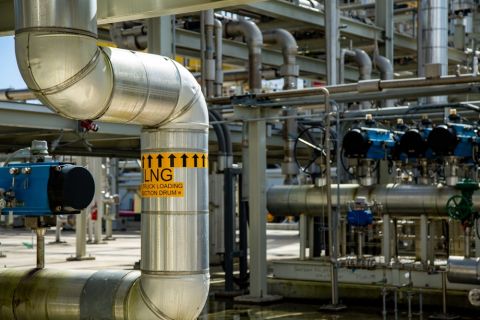When demand for services dropped by more than 50% in first-half 2009 as E&P customers slashed drilling plans in response to the collapse of commodity prices, oilfield service and supply companies took it on the chin. They quickly bolstered their financial resources to weather the storm.
“Like everybody else in this industry, we scrambled most of the year to downsize our organization, limit expenses as much as possible and just live with a substantially reduced business,” says Ken Huseman, president and chief executive of Basic Energy Services Inc., based in Midland, Texas.
“We’ve taken a lot of the cost out of the business by streamlining our organization.”
Larry Pinkston, chief executive officer of Unit Drilling Co., says the first three months of 2009 were spent rapidly adapting to the changing environment by reducing the size of the company. “Rates were coming down quickly and you had to make adjustments all the way down.”
The momentum shifted in second-half 2009, he says, as E&Ps began drilling more aggressively and the rig count began steadily increasing. “We’re gradually putting rigs back to work.”

Basic Energy Services Inc. professionals closely monitor sand blending during the fracturing process.
Houston-based fracturing technology company Carbo Ceramics Inc. chief executive officer Gary Kolstad says the precipitous drop in rig count was the worst the industry has seen in 30 years, but operators’ need for frac proppant for horizontal and shale well completions, in spite of a lower well count, softened the economic hit to his business.
“It turned out to be a pretty good year for us,” he says. “We weren’t immune to the downturn, but it wasn’t as bad for us as it was for others.”
These three companies illustrate what the service and supply sector has endured over the past year. Yet, what is the status of the marketplace now for oilfield services, and what might 2010 hold?
Basic’s instincts
With most of its costs attributable to labor, Basic attacked its head count when the market for oilfield services declined precipitously, reducing personnel by 27% from the peak. The company also revised work schedules, reduced wages, eliminated benefits and froze spending. “Anything we could do to not spend cash,” chief executive Huseman says.
Basic’s operations are centered on its largest segment, well servicing and workovers, with more than 400 service rigs in 11 states. It also runs a comprehensive fluids-logistics business, a pressure-pumping segment focused on smaller markets, a fishing and rental tools service, and contract drilling.
Huseman was determined to maintain market share during the trough, and aggressively set prices to be competitive as customers reduced the number of vendors they employed. Basic saw its rates plummet by about 25% to 30% in the early part of 2009 before leveling out by July, and they have since been “rocking along the bottom” without significant change.
Rates dropped close to breakeven for the highest-cost provider in any particular market but Huseman doesn’t expect them to fall further. “In fact, we expect that wage inflation will cause rates to start increasing sometime in 2010 as activity picks up and we have to start bidding for labor again.”
Quality of service, too, took precedence. “You can’t cut back on the quality of service. In fact, you have to improve it.”

"We've taken a lot of the cost out of the business by streamlining our organization," says Ken Huseman, president and chief executive of Basic Energy Services Inc.
The company did that by eliminating less-experienced people as it trimmed the number of crews, and it high-graded equipment by stacking maintenance problems to the side. “We kept our best people and our best equipment in the field.”
While cautiously optimistic going into 2010, Huseman says Basic will keep a tight grip on all spending, delaying new hires or the expansion of its operations or fleet.
“We’re holding steady” on expenditures for the 2010 budget, he says. “We’re planning for more of what we’ve just had in terms of activity. We’ll let activity pull us along instead of being in front of it. We have maintained our position in most of our existing operating locations and will wait for activity to increase.”
Oil-oriented regions will see more activity than gas-oriented areas in the coming year, and the Permian Basin, in Basic’s backyard, will be busy. “We’re seeing a more normal level of maintenance-related activity as customers work to keep their existing wells in production,” Huseman says.
With its focus on well servicing, Basic is more affected by well count than rig count, and favorable oil prices have bolstered that activity. E&P projects in the works in the Permian include workovers, enhanced recovery, infill drilling and developmental drilling. “We think the Permian is going to really pick up.”
Huseman is optimistic about oil. Prices near $80 a barrel are well above what customers need to keep existing wells in production and optimize production through workovers and drilling, he believes. “If our E&P companies own oil production, they’re going to keep those wells in production and pump as much of that as they can.”
The Bakken oil-shale play in North Dakota will “obviously be very busy” as well. Basic is active there too, with two rigs in the play and 11 overall in the Williston Basin. It plans to increase that activity by 50% during the year.
However—shale plays excepted—gas-oriented regions will be restrained. “It’s too early to nail down hard and fast plans for next year because gas prices right now are subeconomic for most activity,” says Huseman. Eventually gas production will roll over and gas activity will rebound, but “we just don’t know if it’s going to be mid-2010 or mid-2011. We’re planning on it being awhile.”
E&P spending is the lifeblood of the service and supply sector, and Huseman anticipates capital outlays to increase this year.
“There will be more money spent this year than in 2009. It may be redirected more to oily prospects, but with pricing being on average lower in 2010, E&Ps will get more activity done for the same dollar than they would have in 2009.”
Huseman’s outlook for 2010 remains “pretty cautious,” and while he is excited about oil prospects, the company’s even exposure to gas tempers that excitement. An industry-wide glut of stacked equipment keeps him realistic as well. “We have too much equipment chasing available work, so it’s going to keep a lid on profitability.”
Even so, the recovery trend will continue through next year. “We think 2010 will be moderately busier, primarily driven by oil-related activity in our markets, which will offset flat gas activity.” And while activity will likely be modest compared with recent years, “We’re going to have more fun in 2010 than we did in 2009.”
Optimistic clients
Tulsa-based Unit Drilling Co., the contract drilling division of Unit Corp., is one of the largest onshore drilling companies in the U.S. with 130 rigs operating in the Anadarko and Arkoma basins, the Rockies and the Gulf Coast. Its fleet is mainly equipped to drill for deep gas.
For Unit, says chief executive Pinkston, the market bottomed in June along with the rig count but has since been steadily working its way back up. “We’ve been putting rigs back to work gradually. We were laying people off for six months, and now we’re trying to hire some of them back.”
Rig utilization for Unit during the first nine months of 2009 held at 30%, compared with 80% for 2008. As the supply of natural gas declines due to fewer wells being drilled in 2009, Pinkston believes the demand for drilling rigs will grow—“as long as we see improvements in the domestic and global economies.” He doesn’t expect utilization to double in 2010, although he perceives more optimism among his clients.
“Our customers are again talking about multiple-well drilling programs vs. six months ago, when they were talking about single wells—if they were talking about any wells. There is more optimism than three or four months ago.”
Day rates have hit bottom as well, but not yet turned the corner. Although in some areas day rates were still slightly declining in fourth-quarter 2009, Pinkston expected them to be stable by the end of the year. Rates have leveled off, yet are 30% to 40% down year-over-year.
Unit Drilling’s 2010 budget will remain flat with no plans to expand the rig fleet. This is about 30% lower than its 2008 budget. Instead, the company will concentrate on refurbishing and upgrading rigs, converting mechanical rigs to electric, and putting bigger mud pumps and top drives on its existing fleet to make them as competitive as possible.
“The demand for 2010 is going to be for the 1,000- to 1,500-horsepower rig size. We want to make sure as many rigs as we can afford are competitive in that range. That’s our goal for 2010.”
Natural gas prices will drive demand for the service side of the business, he says, and overall wellhead prices need to stay higher than $5 per MMBtu to sustain activity.

"The demand for 2010 is going to be for the 1,000- to 1,500- horsepower rig size," says Larry Pinkston chief executeve officer Unit Drilling Co.
Shale-gas plays will dominate oilfield service company attention this year, predominantly the Haynesville, Eagle Ford, Barnett, Marcellus, and western Oklahoma plays such as the Granite Wash. Unit Drilling is active in all of these except the Marcellus.
In contrast, dry-gas basins with no associated oil or liquids will be slow this year, he believes. For example, “southeastern Oklahoma is going to be tough to make the economics work with gas prices where they are.”
The Bakken oil play will also see fervent activity. While the Permian Basin is prolific in shallow-oil opportunities, the deeper nature of the Bakken in North Dakota and Montana attracts Unit’s bigger rigs. “Our plans are to get more involved in the Bakken oil play. We’re going to go where the demand is.”
Unit Corp. realized an unanticipated benefit from the downturn. As its three divisions slowed down operations, the company was able to trim debt from $200 million to $30 million.
Pinkston’s outlook for 2010 is for a slow and steady recovery. “We will see a gradual improvement in the service industry, but not dramatically. Demand should start coming back for the product, which is what we lacked in 2009. The biggest factor is going to be the economy.”
Positively proppant
The world’s largest ceramic proppant supplier, Houston-based Carbo Ceramics, has avoided the direct body blow the economy delivered to many other oilfield suppliers. In fact, chief executive Kolstad quantifies 2009 as “a pretty good year.” That view is relative.
While the rig count dropped hard and fast in the six months following September 2008 to 50% of its peak, Carbo’s business lines dipped a mere 15%.
“We were very fortunate,” Kolstad says. “Unlike the industry, we didn’t experience the enormous drop. The biggest part of our business is our proppant business, and at the end of the day our proppant makes wells produce better and results in higher reservoir-recovery factors. That works in good times and bad.”
Carbo’s proppants are used in hydraulic fracturing to improve reservoir productivity. They are key to continuing active plays such as the Haynesville, Marcellus, Eagle Ford, Woodford, Bakken and Montney shales. Its other business segments include FracproPT fracture-stimulation software and StrataGen Engineering consulting services.
While economic challenges resulted in significant reductions in drilling and completion activities in early 2009, the percentage declines Carbo experienced were far less severe than the rig count decline as demand for proppant remained strong. Carbo’s U.S. proppant sales in second-quarter 2009 increased by 1% compared with a 30% quarterly drop in rigs running. In the third quarter, the company fared even better, with U.S. sales improving 37%, although globally the company experienced a 3% decline.
The reason for the seeming contradiction is an increase in fracturing stages used in U.S. well completions. “Even though we are drilling a lot fewer wells, we’re doing a lot more frac stages per well,” he says. “That’s good for our business. We’ve found a way technically to unlock these unconventional resources, and it requires a larger volume of more conductive proppant. That’s worked well for us.”
A vertical well in the past might have had one to two fracture stages, where horizontal wells today are being completed with 10 to 20 stages, multiplying the amount of proppant used per well by a factor of 10. And while five years ago only 10% of wells drilled were horizontal, now better than half are horizontal.
“Even though the rig count is down, our business on a per-well basis is up enough that it overcomes that collapse in the rig count. E&P operators are willing to make the small incremental investment by employing ceramic proppant in their wells to harvest a higher IRR (initial rate of return).” Carbo has branded this as economic conductivity.
Carbo entered the economic downturn with a rock-solid balance sheet as the company has never carried debt and is self-funding. During 2009, it used the opportunity to buy back shares at a discount. It is retooling one plant in New Iberia, Louisiana, and opening a third proppant production line in the last quarter of 2010 at its Toomsboro, Georgia, facility, which will increase overall capacity by 20%, and all without adding debt. By the end of 2010, Carbo will have nearly doubled its ceramic proppant production capacity since 2007.
“When you don’t have to think about the balance sheet or liquidity, you can spend time on clients, products and markets. We are fortunate to be in that position and to ride out 2009 much better than the overall industry,” says Kolstad.
In October, Carbo used its financial flexibility to purchase BBL Falcon Industries Ltd., a supplier of spill prevention and containment systems for the oil and gas industry. “Coming into the downturn with an extremely strong balance sheet proved to be fortunate,” he says. “It’s an exciting little business. We’ll expand it quite a bit.”
Going into 2010, Kolstad believes drilling activity will trend up about 5% to 8%, but he remains cautious regarding the first half of the year. Natural gas prices will continue to dampen drilling activity, but “you can’t maintain production at the current drilling level. By the second half, production declines will catch up and activity should increase.”
Recommended Reading
SilverBow Rejects Kimmeridge’s Latest Offer, ‘Sets the Record Straight’
2024-03-28 - In a letter to SilverBow shareholders, the E&P said Kimmeridge’s offer “substantially undervalues SilverBow” and that Kimmeridge’s own South Texas gas asset values are “overstated.”
W&T Offshore Adds John D. Buchanan to Board
2024-04-12 - W&T Offshore’s appointment of John D. Buchanan brings the number of company directors to six.
1Q24 Dividends Declared in the Week of April 29
2024-05-03 - With earnings season in full swing, upstream and midstream companies are declaring quarterly dividends. Here is a selection of dividends announced in the past week.
JMR Services, A-Plus P&A to Merge Companies
2024-03-05 - The combined organization will operate under JMR Services and aims to become the largest pure-play plug and abandonment company in the nation.
New Fortress Energy Sells Two Power Plants to Puerto Rico
2024-03-18 - New Fortress Energy sold two power plants to the Puerto Rico Electric Power Authority to provide cleaner and lower cost energy to the island.





